New Mars Forums
You are not logged in.
- Topics: Active | Unanswered
Announcement
#76 2018-01-16 10:16:07
- GW Johnson
- Member
- From: McGregor, Texas USA
- Registered: 2011-12-04
- Posts: 6,070
- Website
Re: Spaceplane
In the Mercury/Gemini/Apollo days, capsule lift was fairly limited. This would be rather typical of any blunt object in hypersonic flight. If memory serves, typical L/D was 0.1 or less. It served mainly to keep the trajectory from steepening too quickly, or for very, very limited cross-range capability.
If you look at the trade study I did for entry from Mars orbit vs ballistic coefficient (the 8-5-12 article and subsequent), increasing ballistic coefficient decreases the Mach 3 altitude dramatically, while not affecting entry gees very much. Steepening the entry angle is an even stronger effect: you smack the surface hypersonically very easily. Entry speed also increases penetration, but it's not all that strong an effect at shallow enough angles. At 100 kg/sq.m, I got Mach 3 altitudes of 20-30 km, right in line with the Mars landers. At 300+ kg/sq.m, I got Mach 3 altitudes under 10 km, even under 5 km as ballistic coefficient approaches 2000 kg/sq.m. This was for entry at 1.63 degrees below horizontal: tricky to enforce at best.
I did some "calibration" of this crude model with the published data on Apollo and the return trajectory from the moon. At 2 degree entry angle, I got the 11 gees max that they claimed, with an exit from hypersonics at Mach 3 at an altitude very near 45 km (150,000 feet). That's pretty near to what actually happened on those missions. Cutting entry angle to 1 degree halved the gees. I was surprised and pleased that such a crude, oversimplified model could actually come that close.
The model was developed circa 1953 by H. Julian Allen and associates for predicting warhead entry. It is fundamentally 2-D and intended for steep entry angles. To mis-use this model for capsule entry, I "wrap" after-the-fact the predicted range around the circumference of the Earth (or Mars, or whatever). This stuff was classified at the time, and not reported publicly until the early 1960's. I'm not sure, but I think some of this was reported with deliberate errors in it, to mislead adversaries further.
The documentation of this ancient model in the literature gives closed-form equation solutions for peak gees and peak heating. I found the reported closed-form heating expressions to be grossly in error, and I didn't trust peak gees as a result. What I did in my spreadsheet model was to use the instantaneous heating and deceleration model equations (which I found to be OK if over-simplified and crude), and simply numerically integrate their effects down the trajectory in my spreadsheet. Those answers gave me peak heating (and gees), and heating integrals, that I really trusted as realistic.
Heating at Mars is just a lot less because all the entry speeds are far less, even for direct entry from an interplanetary trajectory. The highest of these is still less at 7.5 km/s than LEO entry on Earth (8 km/s), and way far less than return from the moon (11 km/s). Mars escape is only 5 km/s, and LMO entry speed is a tad less than 3.7 km/s. Free return at Earth from an interplanetary trajectory from Mars is near 17+ km/s. That's REALLY demanding!
My 1.63 degree entry figure from LMO came from the arbitrary choice of a deorbit burn that converted a 200-300 km circular orbit into a surface-grazing ellipse (certain to hit the surface). The deorbit delta-vee for this was only 50 m/s, which is something you could actually do with slightly-oversized attitude control thrusters.
GW
Last edited by GW Johnson (2018-01-16 10:21:45)
GW Johnson
McGregor, Texas
"There is nothing as expensive as a dead crew, especially one dead from a bad management decision"
Offline
Like button can go here
#77 2018-01-17 11:55:52
Re: Spaceplane
In the Mercury/Gemini/Apollo days, capsule lift was fairly limited. This would be rather typical of any blunt object in hypersonic flight. If memory serves, typical L/D was 0.1 or less. It served mainly to keep the trajectory from steepening too quickly, or for very, very limited cross-range capability.
If you look at the trade study I did for entry from Mars orbit vs ballistic coefficient (the 8-5-12 article and subsequent), increasing ballistic coefficient decreases the Mach 3 altitude dramatically, while not affecting entry gees very much. Steepening the entry angle is an even stronger effect: you smack the surface hypersonically very easily. Entry speed also increases penetration, but it's not all that strong an effect at shallow enough angles. At 100 kg/sq.m, I got Mach 3 altitudes of 20-30 km, right in line with the Mars landers. At 300+ kg/sq.m, I got Mach 3 altitudes under 10 km, even under 5 km as ballistic coefficient approaches 2000 kg/sq.m. This was for entry at 1.63 degrees below horizontal: tricky to enforce at best.
...
GW
When researchers refer to Mach values with respect to Mars are they using the same sound speed as on Earth? The speed of sound in a gas depends both on the molecular weight of the gas and the temperature. Both of these would be different on Mars.
About the hypersonic L/D ratio, these are commonly taken to be well less than 1, such as for capsules, and for the space shuttle it was only about 1.
But if you had a significantly higher L/D, you could remain at high altitude longer, thus taking longer to descend deep into the dense atmosphere, and thereby reduce heating.
It is notable then there are airfoils that can get a hypersonic L/D of 7:
Hypersonic Vehicle Design.
http://www.aerospaceweb.org/design/wave … sign.shtml
Bob Clark
Last edited by RGClark (2018-01-17 13:41:29)
Old Space rule of acquisition (with a nod to Star Trek - the Next Generation):
“Anything worth doing is worth doing for a billion dollars.”
Offline
Like button can go here
#78 2018-01-17 12:51:20
- GW Johnson
- Member
- From: McGregor, Texas USA
- Registered: 2011-12-04
- Posts: 6,070
- Website
Re: Spaceplane
Sound speed is proportional to the square root of molecular weight and absolute temperature. Molecular weight on Mars is near 44 when it is 28.97 on Earth. Temperatures on Mars are a whole lot lower than here. The two effects more-or-less offset each other, so the sound speed is not all that very different between the two surfaces.
Specific heat ratio "gam" is in there, too, and it's a bit lower on Mars, as well: c = (gam gc Ru/MW T)^0.5, where "gc" is the gravitational constant required to make the units work out, and Ru is the universal molar gas constant. The temperature T needs to be absolute, and is the static or thermodynamic value.
What I used in my estimates was 5-10 km altitude standard model temperatures and the actual molecular weights to calculate sound speeds. So I really did it as "right" as I could. Once in the ballpark like that, I just used it as a near-constant number, even though it still varies slowly with altitude. That error was much smaller than all the other uncertainties and oversimplifications in my ballistic entry model. Even so, it post-predicted Apollo return from the moon pretty good.
Airfoil L/D has a lot less impact than actual vehicle L/D. The non-airfoil potions of the airframe contribute a tiny amount of lift, and an overwhelming amount of parasite and induced drag. The old D-21 drone was a Mach 3 ramjet cruise vehicle with basic shape and construction rather similar to the SR-71. At optimum angle-of-attack (AOA), it had an L/D just a tad above 6. But only at optimum AOA; which means the cruise altitude had to be just right at Mach 3 for that AOA to be optimized. That tradeoff is complex, and derives from lift = weight at cruise, which itself is also shifting as you burn off weight.
Most winged shapes that have traveled hypersonic have had optimized L/D's that ranged from 3 to 6. More of them have been nearer 3 than 6.
As I said above, the capsule shapes have best L/D's under 0.1. But any lifting vehicle shape can be operated at not-optimum AOA, still meet L = W, and thus kill L/D back to next-to-nothing. High L/D is just not something you can hang your hat on, unless you very carefully control the speed-altitude choices of your trajectory to optimize things. It's custom stuff, not generalizable.
GW
Last edited by GW Johnson (2018-01-17 12:58:02)
GW Johnson
McGregor, Texas
"There is nothing as expensive as a dead crew, especially one dead from a bad management decision"
Offline
Like button can go here
#79 2018-01-17 12:57:54
- SpaceNut
- Administrator
- From: New Hampshire
- Registered: 2004-07-22
- Posts: 29,722
Re: Spaceplane
Hopefully these will help to answer the Mars L/D question.
https://charles-oneill.com/blog/mars-at … -profiles/
Design of a Novel Hypersonic Inflatable Aerodynamic Decelerator for Mars Entry, Descent, and Landing
Aerodynamic Prediction and Performance Analysis for Mars Science Laboratory Entry Vehicle
Aerothermodynamic Environments Definition for the Mars Science Laboratory Entry Capsule
Offline
Like button can go here
#80 2018-01-17 13:24:06
- GW Johnson
- Member
- From: McGregor, Texas USA
- Registered: 2011-12-04
- Posts: 6,070
- Website
Re: Spaceplane
L/D for any shape maximizes at a specific angle-of-attack (AOA). To fly at the specified AOA merely requires attitude control, and lift will not necessarily equal weight at all. The lift vector can be pointed in any direction you want by appropriate roll angle control. It can even be pointed downward to help keep you from bouncing off the atmosphere. Your trajectory will tend to bend toward toward wherever the lift vector is pointed, as well as toward where the weight vector is pointed, as the lateral acceleration result of a force vector sum applied to whatever mass you are. Your drag and the weight act pathwise to determine pathwise deceleration.
What I discussed above was the additional constraint of lift-weight for level flight. With both constraints (best L/D AOA and lift=weight), there are only certain altitude densities acceptable for any particular mass, at any given speed in your trajectory. If you cannot enforce both constraints in the trajectory you follow, you will not operate at best L/D.
As for aerodynamics data giving you L/D vs AOA, what we get here from the wind tunnel is what we get in the sky, whether here on Earth or at Mars. The aero coefficient data are universal, and usually functions of only Mach number, and "pretty constant" above Mach 5 (3 for blunt objects). Gravitational acceleration, air density profile with altitude, air gas properties, and air temperature profile vs altitude are not universal. I have been using the Justus and Braun average atmosphere model for Mars, knowing that (unlike here) density varies from this average by factors as high as 2.
GW
GW Johnson
McGregor, Texas
"There is nothing as expensive as a dead crew, especially one dead from a bad management decision"
Offline
Like button can go here
#81 2018-11-22 08:59:44
Re: Spaceplane
GW, about reusable orbital stages, SSTO's or upper stages, I was surprised in most discussions of them it is assumed they are able to reenter to achieve an only 100 m/s terminal velocity. This is true whether horizontal or vertical propulsive landing is being discussed. See for example here:
http://yarchive.net/space/launchers/hor … nding.html
As the example of the space shuttle shows, this is not so surprising for winged, horizontal landing. But the thing is this is assumed even for vertical propulsive landing. This is surprising because this means for a cylindrical rocket stage, without wings, reentering broadside or a conical stage entering base forward, they can cancel out almost all of the ca. 7,800 m/s orbital velocity to get down to only 100 m/s terminal velocity from aerodynamic drag alone.
Actually, I haven't seen the argument for this. Anyone have a reference for the idea you can get down to 100 m/s terminal velocity even without wings?
But if so why all the big debate over vertical vs. horizontal landing? For either method nearly all the 7.8 km/s orbital velocity will already be cancelled out before either landing method comes into play, and even then they only have to account for a measly 100 m/s.
That is surprising though that without even needing wings you can cancel out nearly all of orbital velocity to get down to terminal velocity. Given that, on Earth reentry for an orbital reusable isn't even particularly hard. So why all the hullabaloo about how difficult it is to get full reusability because you also need to return the orbital stage from orbital velocity?
...
Bob Clark
Using short, stubby wings, you can get a lightweight reentry method using a horizontal, i.e, non-propulsive, landing:
Horizontal landing for the BFR on Earth.
https://exoscientist.blogspot.com/2018/ … earth.html
The example of the X-37 shows this works in practice. The well-studied theoretical design of the design of the Skylon provides another example.
Here’s another example of the supersonic fighter the F-104 Starfighter showing short wings can provide a stable landing, keeping in mind an orbital stage reentering broadside is what burns off most of the orbital velocity and the wings are only needed for the final 100 m/s of terminal velocity:
/arc-anglerfish-arc2-prod-mco.s3.amazonaws.com/public/4UVG2DNI6REB3N46F7HABKSA5U.jpg)
Bob Clark
Old Space rule of acquisition (with a nod to Star Trek - the Next Generation):
“Anything worth doing is worth doing for a billion dollars.”
Offline
Like button can go here
#82 2018-11-22 10:23:58
- GW Johnson
- Member
- From: McGregor, Texas USA
- Registered: 2011-12-04
- Posts: 6,070
- Website
Re: Spaceplane
That 100 m/s figure is not an absolute. It is sort of a "class" of speeds. The phrase "low subsonic" is just as accurate, and less misleading.
Terminal velocity happens for a vertically falling object when drag balances weight for unaccelerated motion. That's when W = CD q Aref, where the CD and the Aref "go together", and q ~ 0.7 P M^2 in Earth air. (Note that W/ CD Aref is the ballistic coefficient that must numerically equal q.) This terminal velocity situation is "low subsonic" for most objects falling sort-of broadside at altitudes under about 5000 feet on Earth. For a skydiver falling broadside this is about 120-130 mph. Falling feet-first, it's closer to 250-300 mph. Feet first at 100,000 feet, its closer to 750 mph (a bit over Mach 1).
That F-104 with the stub wings had a landing speed in the 180-200 knot class, like the similarly-shaped X-15. If it were to go broadside in the thick air, even down at landing speed, the wind pressure would rip those wings off. Even in the stratosphere, at typical high-subsonic speeds, going broadside would rip those wings off, and even more certainly at supersonic speeds.
The NF-104 had rockets added at the base of the vertical fin and attitude control thrusters added at the nose, so that it could far exceed its normal flight envelope, for purposes of training USAF space plane pilots back in the early to mid 1960's. Chuck Yeager crashed one in 1964. Its attitude control thrusters failed to put the nose down on a ballistic zoom flight to 100,000 feet. It went broadside during the tumble in air Mars-thin, and at very subsonic speed, without ripping the wings off. But that's a pretty extreme case.
You need thick wings with substantial internal structure to resist ripping off at high AOA and hypersonic speed, even in very thin air. That's easier to do in a delta wing than a straight or swept wing, because the chord is longer: more room for more spars. That's the secret to the space shuttle and the X-37B. Reentry is flown at about 30-40 degree AOA. Once decelerated below hypersonic, AOA is a lot lower. Even at landing, it's only about 20 degrees or so, and it's only that high for a delta wing. Under 15 deg for straight or swept wings. Limited by stalling.
GW
Last edited by GW Johnson (2018-11-22 10:30:06)
GW Johnson
McGregor, Texas
"There is nothing as expensive as a dead crew, especially one dead from a bad management decision"
Offline
Like button can go here
#83 2018-12-25 08:49:25
- SpaceNut
- Administrator
- From: New Hampshire
- Registered: 2004-07-22
- Posts: 29,722
Re: Spaceplane
bump renewed interest in heatshield types
Offline
Like button can go here
#84 2019-04-18 02:21:52
Re: Spaceplane
...
In our scenario though the stage itself would not open up revealing the interior but the extra aerodynamic surface, call them clamshell wings, would be attached to the exterior of the stage. They would be closed up around the stage during low altitude flight, and opened at high altitude.It occurred to me then that this also might be able to be used for reentry. If you can make this extra surface be lightweight then you would get low wing loading. The importance of low wing loading for reentry for spaceplanes is discussed here:
Wings in space.
by James C. McLane III
Monday, July 11, 2011
http://www.thespacereview.com/article/1880/1At the end of the article there is this passage:
Wing loading (the vehicle’s weight divided by its wing surface area) is a prime parameter affecting flight. The antique aluminum Douglas DC-3 airliner had a big wing with a low loading of about 25 psf (pounds per square foot of wing surface). At the other end of the spectrum, the Space Shuttle orbiter has a high wing loading of about 120 psf. This loading, combined with an inefficient delta-shaped wing, makes the orbiter glide like a brick. A little Cessna 152 private plane features a wing loading of about 11 psf and modern gliders operate down around 7 psf. A space plane with huge lifting surfaces and a very low wing loading might not require any external thermal insulation at all. Building a space plane with a wing loading of, say, 10 psf should not be an impossible proposition. Perhaps some day it will be done.
{emphasis added}
Bob Clark
Elon Musk tweeted that SpaceX is considering giving the BFR wings to eliminate thermal protection entirely, though as often happens with Elon you don’t know how serious he is:
https://twitter.com/elonmusk/status/111 … 03360?s=20
Bob Clark
Last edited by RGClark (2019-04-18 02:23:17)
Old Space rule of acquisition (with a nod to Star Trek - the Next Generation):
“Anything worth doing is worth doing for a billion dollars.”
Offline
Like button can go here
#85 2019-04-19 11:35:57
- GW Johnson
- Member
- From: McGregor, Texas USA
- Registered: 2011-12-04
- Posts: 6,070
- Website
Re: Spaceplane
Using wings during reentry does NOT eliminate the need for a heatshield. The space shuttle and X-37B testify to that, as did the old X-20 design. And so does the Dreamchaser design.
Entering dead broadside gets better deceleration and lower stagnation (and local) heating, but hypersonic dead broadside airloads are not survivable with wings light enough to fly. That is why the the shuttle and the X-37B enter at AOA 20 to 40 degrees (wing stalled but otherwise a modest AOA). Lower AOA burns through the windscreen, so does higher AOA due to the complicated aerodynamics associated with not-dead broadside.
If you want wings, AND you want the better deceleration and lower heating of a dead-broadside reentry, then (1) you must stow the wings during entry, (2) you have to un-stow the wings in some way at supersonic, transonic, or high subsonic speeds without ripping them off due to airloads, and (3) you have to have enough wing so that the landing weight divided by wing area ("wing loading") is low enough to permit a practical landing speed.
I did two such stowed-wing spaceplane design studies, one a folding wing design, the other a pivot-wing design. These are posted at "exrocketman" for all to read.
The dead broadside entry attitude reduces stagnation heating sufficiently that aluminosilicates can be used for stagnation zones (unlike shuttle, X-37B, and Dreamchaser).
The wing allows practical landing speeds, at the cost of the design complications of how to stow and unstow, plus protecting that wing and its mechanisms from entry heating.
The hardest part is not entry, or landing. It is controlling speed during the unstow while streamlined after entry is over, so that the airloads do not rip off the wings. That is a very NONTRIVIAL flight dynamics problem. But I have two such solutions posted.
GW
Last edited by GW Johnson (2019-04-19 11:40:53)
GW Johnson
McGregor, Texas
"There is nothing as expensive as a dead crew, especially one dead from a bad management decision"
Offline
Like button can go here
#86 2019-04-19 23:09:42
- kbd512
- Administrator
- Registered: 2015-01-02
- Posts: 8,302
Re: Spaceplane
GW,
Perhaps a hydraulically deployable wing technology similar to the type of wing used by Boeing's GBU-39 would permit a progressive increase in the applied aero loads rather than a single traumatic deployment event.
Offline
Like button can go here
#87 2019-04-19 23:37:10
- RobertDyck
- Moderator
- From: Winnipeg, Canada
- Registered: 2002-08-20
- Posts: 8,238
- Website
Re: Spaceplane
Perhaps a hydraulically deployable wing technology similar to the type of wing used by Boeing's GBU-39 would permit a progressive increase in the applied aero loads rather than a single traumatic deployment event.
Spiral was a lifting body with deployable wings. During development of the Russian space shuttle Buran, they flew an unmanned mockup of Spiral to test the heat shield. It was called "unmanned test article", in Russian the acronym was BOR. BOR-4 splashed in the Indian ocean, Australian intelligence got pictures of it while floating. That gave them density vs water, and centre of gravity. HL-20 was based on it, with modifications. Dream Chaser is based on HL-20. BOR-4 and later had fixed wings, but the original Spiral had deployable wings.
Click image for website of NPO Molniya, the Russian company that developed Spiral. "Directly from the horse's mouth."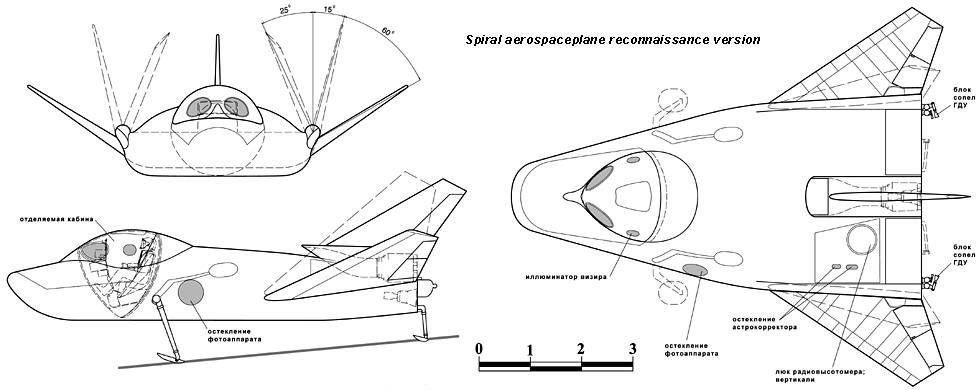

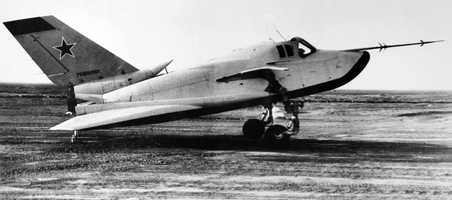
Last edited by RobertDyck (2019-04-19 23:42:44)
Offline
Like button can go here
#88 2019-04-21 02:14:24
- kbd512
- Administrator
- Registered: 2015-01-02
- Posts: 8,302
Re: Spaceplane
Robert,
The Soviets were highly creative and innovative. Their aerospace engineers were consummate professionals. What their concepts lacked in technical refinements, often taken to absurd extremes in the west in my opinion, was more than made up for in terms of general utility and simplicity. Some of what they created was still more advanced than what existed in the west. I can also appreciate their ability to "think big".
I often wonder what we could achieve together if we stopped playing these pointless geopolitical games with each other. After the better part of a century of poking each other with pointy sticks, that sort of behavior has achieved a lot of nothing. I marvel at how capricious and petty politicians can be. When Putin and Trump are gone, there's still hope.
Offline
Like button can go here
#89 2019-04-21 08:33:13
- SpaceNut
- Administrator
- From: New Hampshire
- Registered: 2004-07-22
- Posts: 29,722
Re: Spaceplane
It will take more than just those as it will need to switch from a business that is looking of pork payments to one that gets lean cut seed money and turns them into a business.
Offline
Like button can go here
#90 2019-04-22 12:33:15
- GW Johnson
- Member
- From: McGregor, Texas USA
- Registered: 2011-12-04
- Posts: 6,070
- Website
Re: Spaceplane
The version of Spiral with the folding wings is very much like the straight-wing folding-wing spaceplane concept I evaluated, except my straight folding wing only gets used once subsonic, while Spiral's folding delta got deployed and used earlier.
I posted design studies over at "exrocketman" about a folding straight wing spaceplane, and a pivoting straight wing spaceplane. These were feasibility-of-concept studies, not detailed design studies. Yet the significant issues to address are apparent. I pointed these out explicitly in the later pivot-wing study.
One of the two differences between bringing a cylindrical body back through reentry dead broadside versus 40-ish degrees angle of attack is that the effective ballistic coefficient is lower if dead broadside. That lowers peak heating at the cost of higher airloads over most of the windward surfaces (wings cannot take that and be light enough to fly).
The other difference is complicated aerodynamics (with hypersonic heating risks) at angle of attack, and very simplified low-risk (for heating) aerodynamics if dead broadside.
To go dead broadside, you have to stow the wings out of harm's way, and you have to reconfigure (and partially stow) the tail surfaces to be consistent with that flight attitude.
I repeat: the presence of wings on a spaceplane does not (repeat NOT !!!) eliminate the need for windward-side heat shielding. Whatever Musk might have tweeted about such is nonsense. He ought to ask his reentry aerodynamics people before he opens his mouth about that.
GW
Last edited by GW Johnson (2019-04-22 12:34:32)
GW Johnson
McGregor, Texas
"There is nothing as expensive as a dead crew, especially one dead from a bad management decision"
Offline
Like button can go here
#91 2019-04-23 06:42:56
- Terraformer
- Member
- From: The Fortunate Isles
- Registered: 2007-08-27
- Posts: 3,985
- Website
Re: Spaceplane
There was a Japanese plan a decade ago to launch some paper airplanes from orbit. They were designing them to take I think 200 deg. c. temperatures, but they'd take months to complete re-entry. There was also a plan to use an inflatable glider for crew re-entry.
Use what is abundant and build to last
Offline
Like button can go here
#92 2019-04-23 07:18:16
- tahanson43206
- Moderator
- Registered: 2018-04-27
- Posts: 22,834
Re: Spaceplane
For Terraformer ... re #91
Any chance you could find out a bit more about the inflatable concept for return from orbit?
I recall from recent posts a comment or observation that a light but large object might survive encounter with the upper atmosphere. For example, the Echo balloon (which did NOT survive) was 30.5 meters in diameter. Per the Wikipedia article on Project_Echo, it had a mass of 71+ Kg.
The satellite was NOT designed to survive de-orbit, but I'm wondering if a large balloon (of some kind) might survive.
For example, if the balloon were to roll as it encountered the atmosphere, could it radiate heat while in the side opposite to the heating.
(th)
Offline
Like button can go here
#93 2019-04-23 11:08:51
- RobertDyck
- Moderator
- From: Winnipeg, Canada
- Registered: 2002-08-20
- Posts: 8,238
- Website
Re: Spaceplane
Encyclopedia Astronautica: FIRST (Fabrication of Inflatable Re-entry Structures for Test)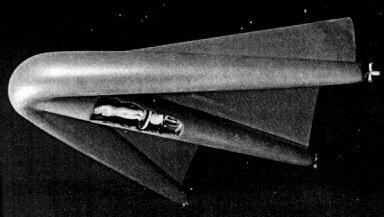
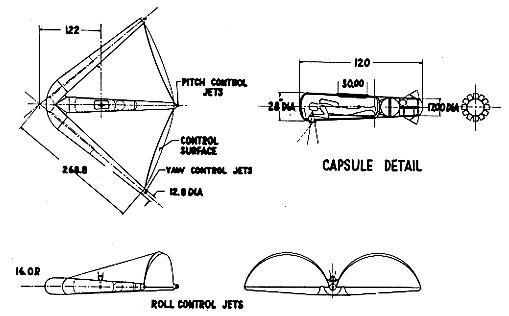
also Encyclopedia Astronautica: MOOSE (Man Out Of Space, Easiest)

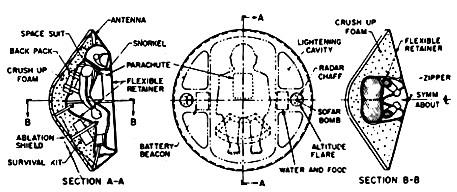
Note: MOOSE had a heat shield. It was folded sections that were unfolded by hand before inflating MOOSE. I don't see a heat shield on FIRST, but it was a Rogallo wing. Early development of Gemini tried to use a Rogallo wing, but they found the inflated support structures folded under load; it failed.
Offline
Like button can go here
#94 2019-04-23 11:40:11
- tahanson43206
- Moderator
- Registered: 2018-04-27
- Posts: 22,834
Re: Spaceplane
For RobertDyck #93
Thanks for both examples !!!
It seems to me that MOOSE has a future as one of a variety of solutions for safe return from orbit, although the notes indicate that at the time of the drawings, a significant amount of work needed to be done.
It took hundreds of years for lifeboats for ocean going ships reached the present state of survivability. We've already seen one example (Shuttle) where a life saving apparatus for individuals would have been useful (if the damage to the wing had been known).
As rapid deployment options continue to develop on a number of fronts (for military needs in particular) we may see a point at which individual recovery systems for space travelers can be deployed to any orbit within hours.
I read a decent amount of science fiction, and no one (to my recollection) has constructed a story around such a theme. There have been lots of stories which feature recovery from system failures of various kinds, but all (again, that I know of) involve survival of a ship.
(th)
Offline
Like button can go here
#95 2019-04-23 12:39:19
- RobertDyck
- Moderator
- From: Winnipeg, Canada
- Registered: 2002-08-20
- Posts: 8,238
- Website
Re: Spaceplane
I read a decent amount of science fiction, and no one (to my recollection) has constructed a story around such a theme. There have been lots of stories which feature recovery from system failures of various kinds, but all (again, that I know of) involve survival of a ship.
Here's a real one. Apollo Rescue Capsule
Various Star Trek episodes and movies involve destruction of a ship, people leaving in escape pods. Star Wars episode IV (A New Hope) was the first movie. It included droids leaving for the planet in an escape pod. And the book "Starship Troopers" by Robert A. Heinlein featured paratroopers deployed from orbit. (The movie was, uh, different to put it politely.)
Last edited by RobertDyck (2019-04-23 12:48:34)
Offline
Like button can go here
#96 2019-04-23 12:53:04
- tahanson43206
- Moderator
- Registered: 2018-04-27
- Posts: 22,834
Re: Spaceplane
For RobertDyck re #95 ...
Nice to see the level of backup planning during the Apollo days!
And! Particularly good to see that the saved museum exhibit was useful for planning design of Orion.
(th)
Offline
Like button can go here
#97 2022-03-03 13:03:41
- Mars_B4_Moon
- Member
- Registered: 2006-03-23
- Posts: 9,776
Re: Spaceplane
A new satellite system sucks in air to provide unlimited propulsion
Offline
Like button can go here
#98 2023-12-24 02:55:20
- Mars_B4_Moon
- Member
- Registered: 2006-03-23
- Posts: 9,776
Re: Spaceplane
Reusable Experimental Spacecraft (CSSHQ) was successfully launched by CZ2F rocket at Jiuquan, Inner Mongolia.
Offline
Like button can go here
#99 2023-12-28 13:17:18
- Mars_B4_Moon
- Member
- Registered: 2006-03-23
- Posts: 9,776
Re: Spaceplane
Starship Flight 3
https://nextspaceflight.com/launches/details/7363
National security: China warns military buffs not to photograph classified equipment
https://www.scmp.com/news/china/politic … -equipment
China's space plane apparently deployed 6 'mysterious wingmen' in orbit
https://www.space.com/china-space-plane … ry-objects
HL-20 Personnel Launch System: The Canceled NASA Space Plane Reborn as Dream Chaser
Offline
Like button can go here
#100 2023-12-29 10:24:15
- GW Johnson
- Member
- From: McGregor, Texas USA
- Registered: 2011-12-04
- Posts: 6,070
- Website
Re: Spaceplane
Thanks. I had not heard when Starship/Superheavy test flight 3 might take place. This soon, it looks like they did not get into trouble with the FAA over test flight 2. That's a good thing.
Dreamchaser would already have been flight tested into space had NASA funded it all along. They funded crew Dragon (which has worked fine for some time now) and Starliner (which has yet to complete its first manned test flight, despite having almost twice the funding).
NASA's process of picking "winners" was apparently to fund the "old space" capsule, and the capsule from among the "new space" entries, not believing any new space outfit could build a space plane (because of "not invented here" attitude). Definitely not the NASA of the 1960's. And you can blame incompetent Congressional micromanagement for that.
GW
Last edited by GW Johnson (2023-12-29 10:32:14)
GW Johnson
McGregor, Texas
"There is nothing as expensive as a dead crew, especially one dead from a bad management decision"
Offline
Like button can go here